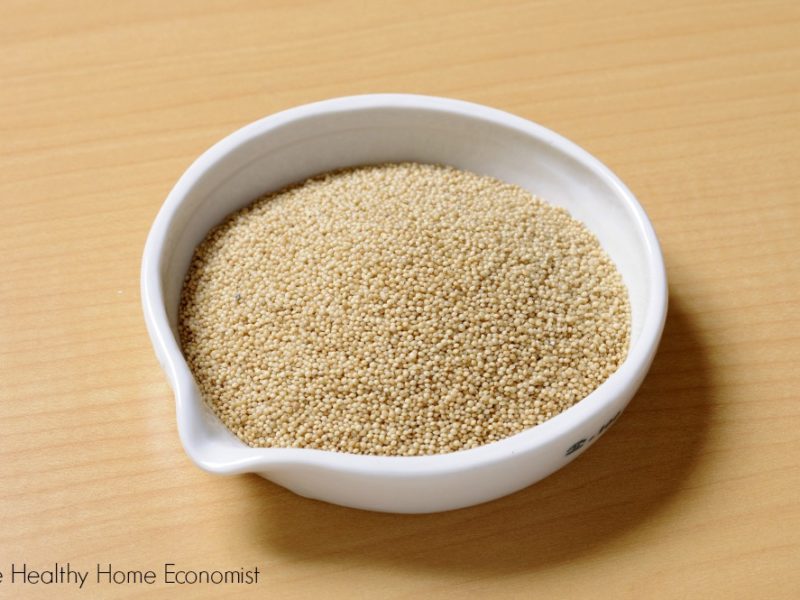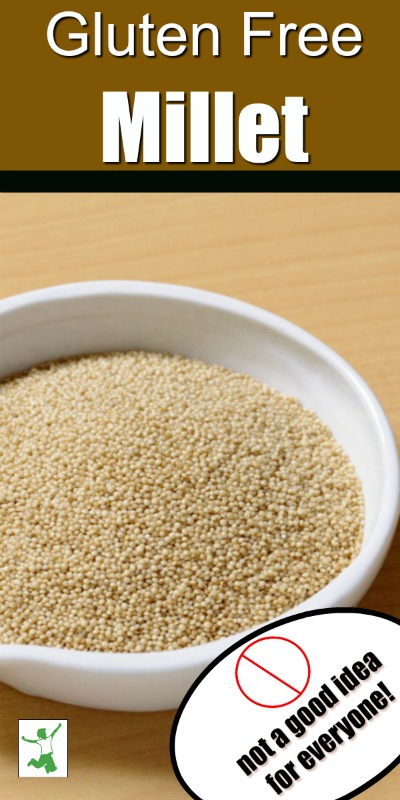Examination of why millet should optimally be eaten in moderation as a gluten-free whole grain in order to avoid disrupting hormone health.

Gluten allergies are clearly on the increase in our modern society. It seems like practically every other person I know these days has some sort of digestive issue that avoiding gluten would probably improve.
At the top of the list of gluten-containing foods is wheat. It is the indisputable, primary staple of the Western diet. Wheat is also the very foundation of the controversial USDA Food Pyramid.
Given how important bread and other wheat-based carbohydrates are to our society’s basic food requirements, it’s no wonder that folks seek a quick and easy substitute for wheat bread and wheat-based snacks when a gluten allergy or Celiac disease has been diagnosed.
Millet: Ancient Gluten-free Whole Grain
Enter millet. This ancient grain was cultivated in East Asia as far back as 10,000 years ago, according to archaeologists. Surprisingly, the cultivation of millet in prehistoric times was more prevalent than even rice, particularly in what is now China and the Korean peninsula.
Millet’s resistance to drought is perhaps the reason for its popularity in ancient times and its spread to Europe by 5000 B.C.
Despite the 5000 years cultivating this whole grain as a staple food, millet porridge is considered a traditional food in Russia as well as China. Use of millet is also widespread in Africa, like gluten-free teff, likely due to the drought-prone climate.
Millet Bread: Logical Substitute for Wheat
The protein structure of millet is quite similar to wheat. The one glaring exception is that millet is a gluten-free grain. Wheat contains copious amounts of this hard to digest plant protein.
When plain millet flour is used for baking bread (as opposed to homemade gluten-free flour or a healthy gluten-free flour mix from the store), the resulting loaf is light, white, and quite similar in texture to wheat bread. As a result, people who wish to avoid gluten tend to immediately gravitate to millet bread as the most logical and palatable substitute.
Millet bread is extremely popular in health food stores. Sami’s Bakery and Deland Bakery are two local bakeries that sell an absolute ton of millet bread to these stores around my local metro area.
I recently corresponded with a person up the East Coast of the USA who was consuming a lot of the millet/flax chips as an alternative to wheat-based snacks and had no idea of the potential health risks from consuming so much millet.
It was this discussion that led me to write this blog and warn folks about the dangers of consuming too much millet!
Potent Goitrogens
While millet does not contain gluten, it does contain goitrogens. These are substances that suppress thyroid activity and can lead to goiter. This condition involves enlargement of this very important gland which resides in the throat. Low iodine intake can also lead to goiter for those who rely on millet as a staple according to the Journal of Endocrinology and Metabolism.
Hypothyroidism is a serious and sometimes debilitating condition. It accompanies a weak or enlarged thyroid such as what occurs with goiter. Depression, difficulty losing weight, loss of hair, cold hands/feet, and fatigue are common hypothyroid symptoms. By some estimates, hypothyroidism is at epidemic proportions in Western society. (1)
Goitrogens in foods that contain them are usually reduced by cooking such as cruciferous vegetables like broccoli. However, cooking actually increases the goitrogenic effect of millet! Incidentally, the same effect occurs when fermenting soy.
Therefore, when folks begin eating large amounts of millet bread with a wholesale switch over from wheat, the thyroid suppressing effects of this simple dietary change can be profound. Injuring the thyroid can have a cascade effect on other glands as well. For example, those suffering from adrenal fatigue many times have thyroid issues as well.
Moderation is Critical
Protect your thyroid at all costs! It is a real challenge to unwind the effects of hypothyroidism once this vital gland is weakened or enlarged. Don’t take any chances with your thyroid health by consuming large amounts of millet bread or millet based snacks.
If gluten and/or wheat is a problem, then simply reduce bread consumption. Alternatively, use another grain that is both gluten-free and non-goitrogenic such as rice, oats or teff. Be sure to get quality, though, as rice is frequently high in arsenic.
Alternatively, try using grain-like gluten-free foods such as highly nutritious buckwheat, amaranth, or the starchy tuber cassava. They are excellent for baking too!
Millet bread consumption is fine in moderation if your thyroid is healthy – just don’t overdo it!
Given how difficult it is in modern society to maintain thyroid and overall glandular health, taking a chance by eating a lot of millet bread is a risky proposition indeed.
Traditional peoples did not have the constant stresses and strains on their glands like modern people do.
For example, they did not have to contend with pollution of their food, water, air and overall environment.
Therefore, we must be overprotective of our thyroid health. This includes avoiding regular consumption of foods that might impair it in any way.

Millet Alternatives That Preserve Thyroid Function
If you have thyroid issues and need alternatives to millet, here is a list of the healthiest options to consider.
- Einkorn Benefits (contains “good gluten“)
- Teff Benefits
- Yuca Root Benefits
- Arrowroot Benefits
- Wild Rice Benefits
- Farro (great if only modern wheat is the problem)








I appreciate your knowledge and your mission, but there is nothing wrong with gluten and people do not have gluten allergies. I’m sixty and when I was a kid no one had trouble with gluten. The problem with grains today is that they are saturated with Round Up, the active ingredient being glyphosate, and glyphosate is a poison. Only eat organic grains and you will not develop a gluten intolerance.
The problem with wheat today, which differs from 50 years ago, is that it is hybridized – who the heck knows what they are adding to the wheat for bigger profits. All I know is that I had a pain in the back of my knee – my energy doctor only saw inflammation. He did not see a baker’s cyst, or some other issue. The pain disappeared within a couple of days when I stopped eating gluten. Also, every time I talk to women and they have no tummy, I ask them if they eat bread or pasta. What do you think the answer is? No! Bread and pasta are so unhealthy to eat these days, not to mention sugar. But this is the typical American diet.
If millet is goitrogenic, why not add kelp powder to the bread ingredients which will supply the Iodine support that the thyroid may need …?
That’s a great idea! It would probably work fine for some folks … unfortunately, it seems those of Western European origin seem particularly susceptible to thyroid issues from goitrogenic foods. Those from other cultures seem more resilient particularly those where millet is a staple for centuries such as Africa.
The comment about rice -the staple food of a large percentage of the world’s population, some of them very long living, casts doubt on comments about millets. That and the complete lack of quantitative data.
Did you read the article? Some cultures are more resistant to thyroid disorders than others! Westerners have not had millet traditionally in the diet except in the last few decades. They are more susceptible to thyroid inhibiting effects.
Hi
I would like for someone to definitively tell us here if all types of millet can cause goiter. As someone trying to lead a healthy lifestyle and with a child with allergens of every kind imaginable, It scares me to think that EVEN millet is nay good afterall!
I use millet grown in Africa, Kenya specifically in the Kisii region. This millet( I believe it is finger millet) is grown by hand , weeded by hand and milled in the local village in ajust a simple posho mill operated by water!. No chemicals, no additives no preservatives.. just the tiny seeds from start to our tummies here in the USA. Oh yeah, all this is done by my family back there..
Please someone let us know if finger millet can cause goiter in children or adults etc.
Thank you!
From my research, all types of millet are goitrogenic to some degree.
Millet is better than wheat for heart in hypertension patient?
The research in this is based mainly upon one study that did not study the entire grass only subsections of the grain. Anytime you drill down to one specific particle of an item you may find it is not good for you. This study also dealt with iodine deficiency which in the US is not a typical player. “For use in these studies, whole grain millet was progressively dehulled to yield successively four bran and four flour fractions in which direct analyses revealed progressively lower concentrations of C-glycosylflavones.” So, as you can see the the whole grain as is it eaten was not studied. Coming from a family with a genetic predisposition of Hashimoto Syndrome, I am always very careful in reviewing data for its efficacy. Just because it is on the internet does not mean it is true. Also, I am curious, did you read the entire study? The abstract has this last line which I did not see referenced in your opinion piece “We conclude that in areas of iodine deficiency in which millet is a major component of the diet, its ingestion may contribute to the genesis of endemic goiter.”
Just an FYI – certain breeds of Millet are not a Goitrogen, like Proso Millet. Please update your info in order to not misinform your audience. You can always ask your millet supplier which kind they grow. Although I wonder why people would want health advice from an economist, but hey…
Cheers!
I haven’t been able to find a single credible source that proso millet is non-goitrogenic. A search of pubmed produced nothing. Please post links if you have any.
Ellen Wertheimer – In addition, these issues come about because of Iodine Deficiency. There are many reasons to keep your iodine intake up, so if you make sure that is taken care of it appears millet is fine. There is no research I can find which shows a risk without iodine deficiency. Please correct me if I am wrong.
Millets are useful or not to diabetic patients.answer please
Hi
My name is Amal I’m on FODMAP I do my own br
Bread with buckwheat and chia so what do you think is healthier millet or buckwheat